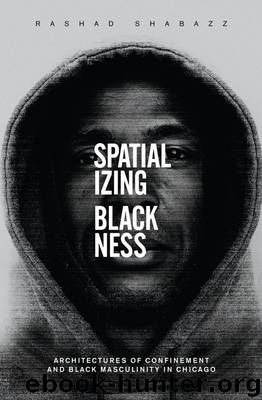Spatializing Blackness: Architectures of Confinement and Black Masculinity in Chicago (New Black Studies Series) by Rashad Shabazz

Author:Rashad Shabazz [Shabazz, Rashad]
Language: eng
Format: epub
Tags: USA, Geografia
Publisher: University of Illinois Press
Published: 2015-08-29T22:00:00+00:00
Conclusion
Finally fed up with fighting a war against crime they could never win, the CHA demolished the Robert Taylor Homes in 2007 (along with several other housing projects), dispersing residents throughout the city. The displaced were offered housing vouchers (formerly Section 8) to help with the move; however, many residents had difficulty finding places to live. The stigma of being a Robert Taylor resident made it difficult for many to get housing.88
Razing the Robert Taylor Homes was the end of an era. It was the knocking down of walls, which contained poor Black residents who were enabled by racist public policy. Demolishing the project also dispersed residents across the city, many of whom had been close neighbors and in some cases even family. Some saw this move as positive—seeing the world “outside” the projects for the first time. For others, the move was the end of a community they knew. But all residents were not ready for this transition, as the closed world of the project did not prepare residents to adjust to their new surroundings.
In the end, what did the Robert Taylor Homes achieve? In a word: little. The project drained massive amounts of federal and state resources, stigmatized residents, produced and reinforced poverty, contained and diminished life chances, fattened state prisons, prepared people for prison, and in far too many cases led to premature death. The project was not a success story. Chicago is now dealing with the consequences of decades of containment. Anecdotes about the impact of “letting people out of the projects,” which shows how widespread the project-as-prison idea is, pepper news stories, beauty salon chatter, and barbershop talk in the city. In a letter to his father from prison, George Jackson solemnly described the way prison diminished his outlook on life: “I used to find enjoyment in walking in the rain, summer evenings. … All that is gone from me, all the gentle, shy characteristics of the black men have been wrung unceremoniously from my soul.”89 Prison put his soul to death long before mortally wounding his body. In the following chapters I examine the impact carceral power had on Black men who came of age during the 1980s, 1990s, and early in the twenty-first century. Beyond a focus on high incarceration rates, I demonstrate carceral power’s effects on gender performance and health.
Download
This site does not store any files on its server. We only index and link to content provided by other sites. Please contact the content providers to delete copyright contents if any and email us, we'll remove relevant links or contents immediately.
| African-American Studies | Asian American Studies |
| Disabled | Ethnic Studies |
| Hispanic American Studies | LGBT |
| Minority Studies | Native American Studies |
Cecilia; Or, Memoirs of an Heiress — Volume 1 by Fanny Burney(32434)
Cecilia; Or, Memoirs of an Heiress — Volume 2 by Fanny Burney(31871)
Cecilia; Or, Memoirs of an Heiress — Volume 3 by Fanny Burney(31854)
The Great Music City by Andrea Baker(31349)
We're Going to Need More Wine by Gabrielle Union(18967)
All the Missing Girls by Megan Miranda(15571)
Pimp by Iceberg Slim(14394)
Bombshells: Glamour Girls of a Lifetime by Sullivan Steve(13973)
Talking to Strangers by Malcolm Gladwell(13222)
Norse Mythology by Gaiman Neil(13206)
Fifty Shades Freed by E L James(13157)
For the Love of Europe by Rick Steves(12992)
Mindhunter: Inside the FBI's Elite Serial Crime Unit by John E. Douglas & Mark Olshaker(9201)
Crazy Rich Asians by Kevin Kwan(9167)
The Lost Art of Listening by Michael P. Nichols(7406)
Enlightenment Now: The Case for Reason, Science, Humanism, and Progress by Steven Pinker(7235)
The Four Agreements by Don Miguel Ruiz(6631)
Bad Blood by John Carreyrou(6552)
Weapons of Math Destruction by Cathy O'Neil(6146)
